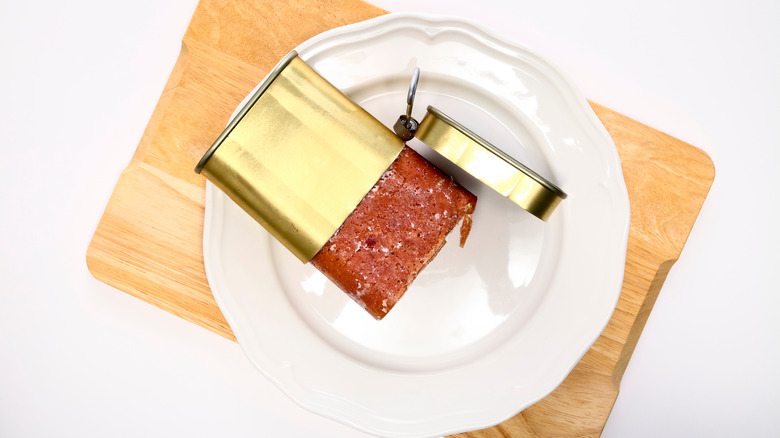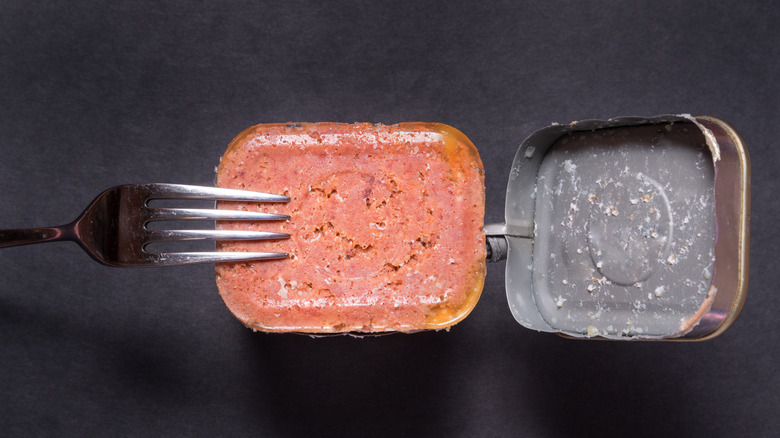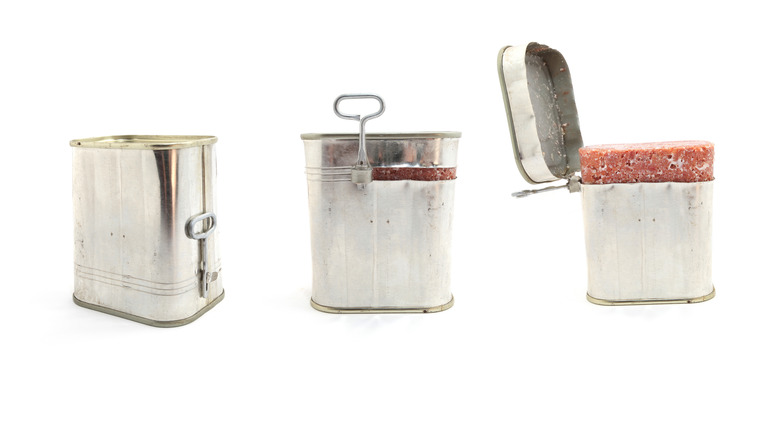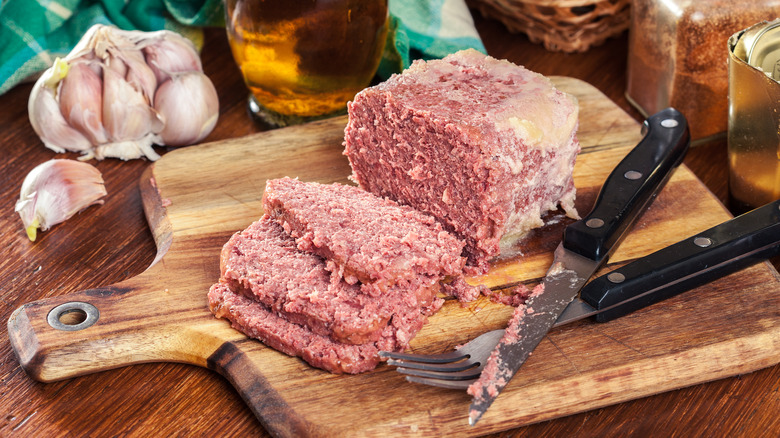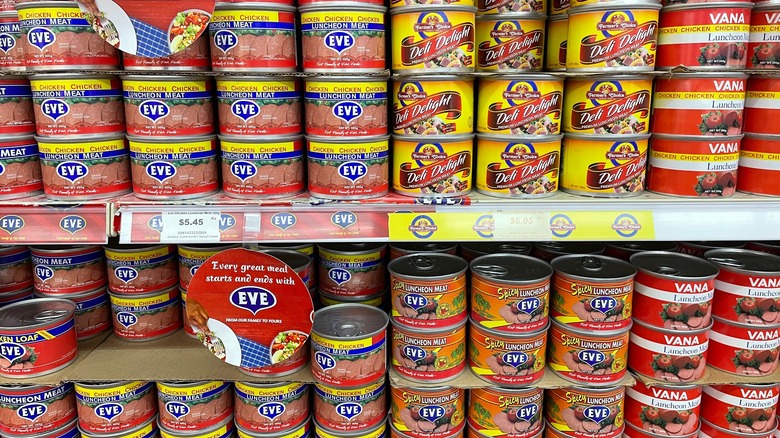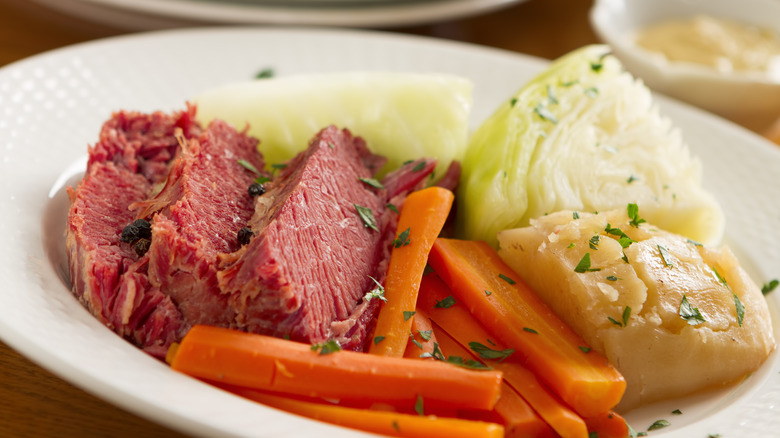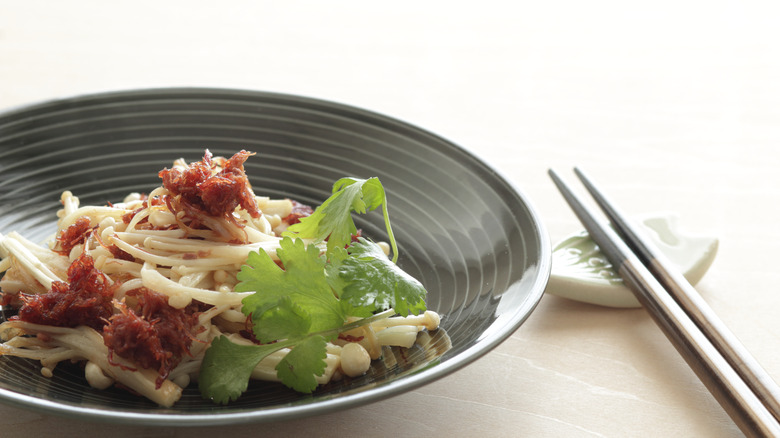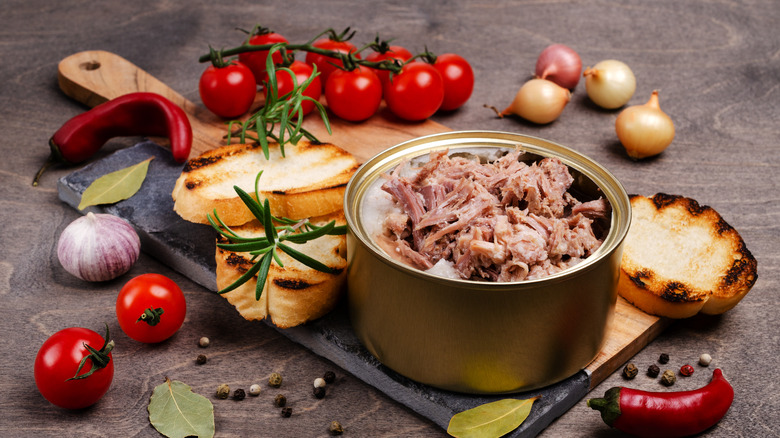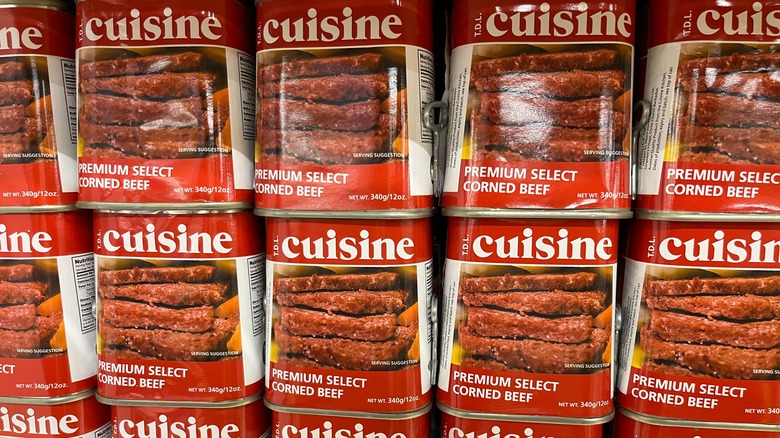The Ultimate Guide To Canned Corned Beef
Sure, that can of corned beef hash in your pantry may not look like much — you may not even be sure what to do with it. But, you may be surprised just how much that little can has to offer, and what an important role it's played in the food landscape we know today.
This remarkably versatile dish originates from ancient food preservation methods, such as the Mesopotamian used around 3000 B.C. Fast forward to the modern day, and you'll find canned corned beef at the side of sailors and soldiers alike, providing a cheap, easy, and hearty meal on the go.
Beyond its utilitarian roots, canned corned beef offers many culinary possibilities. Packed with robust flavors, corned beef holds a unique place in both kitchens and cultural cuisines. From classic comfort foods to inventive contemporary dishes, the possibilities are as varied as the imagination. Create hearty hashes, elevate sandwiches to the next level, or surprise your taste buds with unexpected fusions.
In this comprehensive guide, you'll learn all about the nuances of canned corned beef, explore its production process, and learn how to incorporate it seamlessly into your own recipes. So, whether you're a curious food enthusiast and history buff or simply someone looking to add a touch of culinary nostalgia to their dinner plate, join us as we discover what makes canned corned beef a staple worth celebrating.
A quick history of canned corned beef
Beef has a long history of being canned for preservation, having first been canned for long-term preservation in about 1806 by a Frenchman named Nicolas Appert. Appert was looking to develop a way to preserve and store food for the French Army and began working on his preservation process during the French Revolutionary Wars.
Later, in 1810, British inventors John Hall and Bryan Donkin came up with an "appertization" technique that allowed food to be sterilized in tinplate cans. But, it wouldn't see its heyday as an indispensable staple until World War II when the United States army needed a cheap and easy way to transport food without it going bad.
Today, canned corned beef is not just a cheap foodstuff in America — it's a culinary must-have for countries worldwide. As the U.S. military established itself in Asia and the South Pacific during the mid-20th century, canned corned beef was embraced more and more by countries like Hawaii and the Philippines, where locals began incorporating it into traditional meals (like corned beef silog). And, canned meats like corned beef were especially important in regions where there was limited access to refrigeration.
How is canned corned beef made?
The process of making canned corned beef usually starts long before it ends up in the can. Generally, the beef cuts selected for canned corned beef include tougher meat portions like brisket or round, which can stand up to the extended cooking and curing process. Next, the beef enters the curing stage, which is a crucial period where the beef is prepped for preservation. The selected beef is placed in a curing solution known as a "brine" which consists of water, salt, and various spices like bay leaves, coriander, mustard seed and peppercorns. This mixture not only seasons the meat but also helps to properly preserve it. The beef is left to soak in the brine for several days, allowing the mixture of salt and spices to permeate the meat.
After the curing process, the beef is typically simmered or boiled until it becomes tender. This can take several hours, depending on the size of the meat cut. The slow cooking process breaks down the tough fibers of the meat, giving it a more tender texture. Then, the beef is cooled and shredded into chunks which are packed and sealed tightly into cans, along with the beef's natural juices or a flavorful gelatin. To ensure the safety and extended shelf life of the product, the sealed cans undergo a process called sterilization, which involves heating the cans to a high temperature to kill any remaining bacteria or microorganisms in the beef.
What does canned corned beef taste like?
Canned corned beef has a distinctive taste that combines the flavors of beef, salt, and spices. It's important to note that taste can be subjective, and individual preferences may vary. When eating corned beef straight out of the can, the initial taste is a balanced mix of saltiness and a slight sourness. It's an interesting interplay of flavors that can be quite appealing.
Because the beef cuts typically used have a high-fat content, the beef itself tastes rich and hearty, even after being soaked in salt brine. But, one of the defining characteristics of canned corned beef is the salty flavor it develops during the curing process.
Canned corned beef can also have some marbling, which contributes to its juiciness and adds flavor. The fat can melt during cooking and distribute through the beef, further enriching the taste. Cooking canned corned beef can alter its taste and texture somewhat. The heat releases more of the spices and aromas, making them more pronounced. The meat tends to firm up a bit and might gain a subtle crispy exterior if pan-fried or baked. The cooking process can mellow out some of the initial saltiness and enhance the savory taste.
Types of canned corned beef
You may think that, based on your personal taste or dietary preferences, you won't find a canned corned beef variety that fits your needs. But, you might be surprised to find out how versatile the canned corned beef market truly is. Canned corned beef is available in various sizes, ranging from small single-serving cans to larger family-sized cans. In response to health-conscious consumers, some brands offer reduced-sodium versions, while others may offer all-natural or organic versions. You can also get finely processed versions of corned beef that resemble spreads or pâtés.
Traditional canned corned beef and corned beef hash are two different products. Corned beef hash typically includes diced potatoes, as well as onions. It's generally pre-seasoned so all you have to do is heat it up. However, traditional canned corned beef does not include any additions, so it's perfect for adding to your own recipes. Some canned corned beef products are packaged in a savory gravy that adds more flavor to the meat and can be served over mashed potatoes or noodles. Depending on where you are, you might find canned corned beef products that cater to regional or cultural preferences.
How to cook canned corned beef
Technically you can eat it straight out of the can — however, there are several ways to cook your canned beef to improve the taste and texture. For something simple and easy, you can take slices of the meat straight from the can and heat it up in the microwave with some salt or seasonings and have it as a sandwich or with some vegetables. To do this, empty the can out on a microwave-safe dish. You may want to break up the loaf to ensure even heat distribution. Cook it on medium power for about one to 2 minutes.
To cook your corned beef on the stovetop, heat a non-stick skillet or frying pan over medium heat. You generally don't need to add extra oil, since the corned beef is already high in fat. Break up the beef into smaller pieces using a spatula or fork and allow it to cook for a few minutes, stirring occasionally.
If you'd prefer to cook your corned beef in the oven, preheat it to around 350°F (175°C). Transfer the corned beef from the can into an oven-safe baking dish. At this stage, you can also add diced potatoes, vegetables, or other ingredients if you'd like to make a casserole-style dish. Then, place the baking dish in the preheated oven and bake for about 15-20 minutes, or until the corned beef is heated through and possibly slightly browned and crispy on the edges.
The best ways to use canned corned beef
By far the most common way to prepare canned corned beef, at least here in the United States, is by putting it into a corned beef hash, which includes canned corned beef that is diced or shredded and cooked with diced potatoes, onions, and often seasoned with spices. It's a hearty and filling breakfast or brunch dish. In fact, it's such a common dish that you can buy corned beef hash already canned and waiting to be heated up! But, there's also a whole world of culinary possibilities waiting to be explored. With a little creativity, you can transform this often underappreciated pantry staple into something totally unique. Or, if you're feeling lazy, simply grab a fork and eat it right out of the can — no judgment here.
From sandwiches and salads to creative pasta dishes, there are limitless ways to use canned corned beef. Add it to Shepherd's pie, pasta, fried rice, casseroles, and many more. Cook it with eggs as a breakfast dish and make your own version of corned beef silog (a traditional Filipino dish), or even add it as the main base in burritos and tacos or as a pizza filling! Since canned corned beef has become such an important part of Asian and Pacific Island cuisine, try incorporating it into Asian-inspired dishes like fried rice, noodle dishes, or even as a filling for spring rolls. It also makes a convenient addition to stir-fries.
Nutritional value of canned corned beef
While canned corned beef isn't exactly the healthiest food around (the WHO considers processed meats like corned beef to cause an added risk of developing cancer), that doesn't mean it should be entirely overlooked. Canned corned beef tends to have a moderate to high amount of fat, and the sodium content can be on the higher side due to the curing process. This is something to be mindful of if you're watching your sodium intake or have heart health concerns.
It's also a decent source of protein, which is essential for muscle maintenance and various bodily functions — a three-ounce serving can contain about 15 grams of protein. However, it's not really an abundant source of vitamins and minerals. It does contain a decent amount of B12, selenium, and iron, but not enough to be considered a substantial addition to your daily intake.
Canned corned beef can range in calories depending on whether it is prepared with anything (like hash), but due to its high-fat content, it is relatively calorie-dense, with about around 200 calories in a 3-ounce serving. Keep in mind that this information is approximate and can vary depending on the specific product you're looking to use.
Storing canned corned beef
Canned corned beef is a convenient and versatile pantry staple, but proper storage is key to maintaining its quality and safety. When canned corned beef is unopened and properly stored in a cool, dry place, it can last for an extended period ranging from 3 to 5 years or even more, depending on the brand and manufacturer.
But, that doesn't mean it will last forever. To maximize its shelf life, store unopened cans in a place with a stable temperature and low humidity like a pantry or cupboard. After opening the can, transfer any unused portion of the corned beef to an airtight container. After cooking your corned beef it can be stored in the fridge, for about 3 to 4 days.
How can you tell if your canned corned beef has gone bad? If it's still in the can, it's a little more difficult, but there are still ways to tell. If you see any visible signs of rust, leakage, or severe dents on the can, then it's likely that it may have gone bad, since these are all signs that air has gotten into the can. If you're still unsure, try opening the can. If the corned beef emits an unusual or unpleasant odor or the color seems off, then the beef is likely bad.
